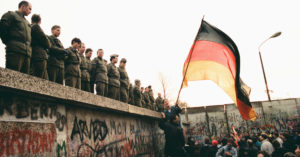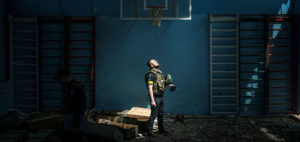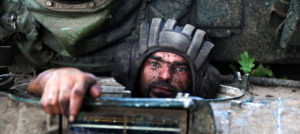During his time as a conscript in a West German artillery unit, my father recalls having to clean the barracks toilet with a toothbrush. This was the early Sixties; he had just graduated from a Gymnasium, the equivalent of grammar school, and was university-bound. His memories of doing military service in between are not pleasant. Petty officers from working-class backgrounds took a sadistic pleasure in bullying him. Once, while his platoon was marching along a forest track, training for an air attack, soldiers had to dive to the ground for cover, and the commander ordered my dad to dive into a water-filled rut. Out of pure depravity, he suspected.
“I hated the pointless discipline,” he tells me 60 years later. But in hindsight, he sees the value of spending 18 months in the Bundeswehr against his will. “Working with people from very different backgrounds helped me manage all sorts of people” — a useful skill for later in life, during his career in business. It also made him a more organised person. “We had a drill called ‘Nato alarm’. We had to get out of bed and be ready to go within 10 minutes. That was only possible if you had all your things in order.” To this day, he’s by far the tidiest person I know.
It was a very different time. Europe was constantly on edge. The 1961 stand-off in Berlin and the Cuban Missile Crisis were recent memories, and the prospect of a hot war between the Eastern Bloc and the West was not out of the realm of possibility. West Germany and Nato trained for what was considered a likely scenario: Soviet tanks pouring in from communist East Germany through the Fulda Gap towards Frankfurt. At the height of the Cold War, the Bundeswehr counted 495,000 soldiers in its ranks.
Now, Nato’s eastern flank is more than a 1,000km to the east and Germany has just 180,000 troops. But, having suspended mandatory military service in 2011, Germany is talking about reinstating it. After the start of Russia’s invasion of Ukraine last year, Chancellor Scholz gave his now-famous Zeitenwende speech, which supposedly heralded a new era of defence readiness. Last month, the new, gung-ho defence minister Boris Pistorius said it was a mistake to end conscription. Inspector of the Navy, Vice-Admiral Jan Christian Kaack agrees, arguing that it’s good for society in uncertain times: “I believe that a nation that needs to become more resilient in these times will have a better understanding if we have intermingling with the soldiers.” It seems that the public is on board. A recent survey found that 61% of Germans believe it was a mistake to suspend conscription.
Despite the conflict raging to Germany’s east, most advocates for conscription’s revival don’t focus on the military benefits. Last summer, when German President Frank-Walter Steinmeier proposed reviving national service in the form of Dienstpflicht, compulsory military or civil service, he used an old argument: that serving your country is a way to integrate young people. “Especially now, at a time when understanding for other ways of life and opinions is waning, compulsory social service can be particularly valuable. You get out of your own bubble, meet completely different people, help citizens in distress.”
In post-war Germany, Wehrpflicht, or military duty, always allowed for conscientious objectors to opt for civil service. By the Nineties, half of the selected young men chose non-military work. A friend of mine drove an ambulance in Munich — an intense, life-changing experience, which included rescuing a man who was romantically entangled with a Hoover. Others wiped bums in care homes or kindergartens. Like my father, most ultimately benefited from serving in their different ways, even if it seemed hard and senseless at the time, an obstacle on their path towards university and a career.
But does it really make sense, in 2023, to reinstate mass conscription? In the decades following the catastrophe of Hitler and World War II, the army was tightly controlled by parliament, and soldiers were meant to be “citizens in uniform”. If all men participated in the armed forces and then went back to normal life, the military could not be a powerful “state within a state”, which is how my dad describes the Wehrmacht during the Second World War. Interestingly, after conscription was halted in 2011, Germany’s all-volunteer army attracted proportionally more unsavoury, far-Right crackpots; some former professional soldiers have even cooked up unrealistic but potentially dangerous plans to overthrow the government or trigger a civil war. Conscription, one could argue, could not just integrate young men into society, it also could help to better integrate the military in the nation.
Compulsory service doesn’t necessarily make military sense, though, even in light of the threat presented by the Russian invasion of Ukraine. Carlo Masala, professor at the University of the Bundeswehr in Munich, imagines two scenarios in which the German army would be deployed: either a Russian attack on an eastern Nato country, most likely one of the Baltics, or a force directly invading Germany’s borders. A large army of conscripts only makes sense in the latter scenario; when your nation is directly under siege, a mass of troops is crucial. But the former scenario is far more likely — in the next two decades at least — and would require Germany contributing a small force of highly trained professionals armed with complex, high-tech kit.
Besides, Germany can’t afford a return to conscription. Masala says it would take five to ten years to build the barracks, purchase training equipment, and hire teaching staff. Annual costs would run in the double-digit billions. It would be much wiser to spend that money on attracting better volunteers by paying them higher wages — and buying them modern weaponry that works.
Because the Bundeswehr has a lot of problems that an influx of new soldiers won’t fix. In the three decades after 1989, German defence fell into complacency, but from around 2015, the dismal state of the military became impossible to ignore. Angela Merkel’s last defence minister tried to boost appreciation for the troops with perks like free train tickets if they travelled in uniform — which wouldn’t be a big deal in most countries, but was controversial in Germany, where pacifism is deeply entrenched. By that point, defence was out of sight and out of mind: something rather distasteful that the Americans conveniently took care of from their huge base at Ramstein. Ironically, it was Donald Trump, a deeply unpopular figure in Germany, who prodded the country to change, with his insistence that Nato members spend 2% of GDP on defence. The Germans, and many other nations, are now aiming to do just that.
The conscription debate has flared up elsewhere in Europe. Latvia reintroduced it in January — hardly a surprising move, given the nation’s proximity to Russia. But Western European leaders are also dusting off the old-fashioned idea that shared military experience is a glue that keeps society from fragmenting. In 2019, Macron introduced a new four-week programme of national service, which will become compulsory. (He has said: “Military experience not only leads you to develop experiences but also behavioural qualities.”) In Italy, Right-wingers like Matteo Salvini have long advocated conscription’s revival: “I believe that a year of teaching the rules, good manners and duties would make good citizens.”
As for Scandinavia, Putin’s 2014 annexation of Crimea reawakened fears of Russian aggression. Sweden reintroduced conscription in 2017, as the number of volunteers was steadily falling. The move was backed by parties on the Right and Left. There is a broad consensus that national service is good for democracy. Every year, the nation selects about 6,000 male and female recruits based on an online survey, with questions about their physical condition and their attitude towards military service. Attitudes are similar in Norway, where 15% of 19-year-old men and women serve. Here, a shared border with Russia adds to the sense that conscription and a large number of citizens with some military training are necessary.
But where I live, in Denmark, the hottest debate about conscription is very different from the one happening in either Germany or nations that share a border with Russia. At the moment, a small number of men are selected each year via a lottery, while women can sign up as volunteers. The government, led by social democrat Mette Frederiksen, is putting together legislation that will make service compulsory for women, too. It’s backed by feminist organisations such as Kvinfo, whose director Henriette Laursen writes: “If women and men are to be included in the Armed Forces on equal terms, military service should be the same for women and men. Therefore, Kvinfo recommends that military service be either extended to women or abolished altogether.”
Of course, forcing women to join the military might not be in their best interests; it can be a dangerous environment for them. Female veterans complain about sexual harassment and tell stories of women sleeping with knives under their pillows to ward off advances. But Laursen thinks the presence of more women will help, saying that the military needs to be cleansed of “macho culture”. Indeed, a Swedish official recently said that the main change since female conscription has been better hygiene among the men.
Equality sounds great on paper. But prominent voices object to the move. Anna Libak, a journalist and veteran, writes: “All women who have served in the armed forces — like myself — must admit that, all other things being equal, men are better soldiers because they are physically stronger than women.” There is, she argues, a fundamental reason why only 8.9% of uniformed soldiers in Denmark are female, and it’s not sexism. Her conclusion might provoke some feminists: having children is necessary for the survival of Denmark and women continue to bear the physical and financial burden of reproduction, so they shouldn’t be forced to carry arms on top. “There are many ways to defend the nation. For example, by giving birth to the conscripts of the future.”
Still, 55% of Danes favour the draft for both sexes — perhaps because most of the young people who serve these days appear to have a blast. The #værnepligt tag on Instagram reveals women in full camo floating in a lake, or a troop marching along a pristine beach at sunset, with captions like, “Hard, fun, challenging, educational, exhausting, adventurous, breaking down, building up, comradely, meaningless, meaningful, memorable! Would love to do it again!”. A far cry from the grim drudgery my father went through in Cold War Germany. In peaceful, prosperous Scandinavia, conscription really is an opportunity to make friends and learn something, just as it would be in Germany. But, in 2023, the image of the army as an Instagrammable adventure clashes violently with the horrors being broadcast from the trenches of Bakhmut.
On the brutal, 1,000-mile front that has divided Europe, the true cost of conscription is revealed: men of fighting age, and it is still largely men, being fed to the meat grinder, whether they like it or not. If, God forbid, war were to spread to Western Europe, having six months’ experience in the army wouldn’t save our young people. As peace continues to reign here, we still have the luxury of debating whether conscription will integrate disaffected young men into society, or whether mandatory military service for women will boost diversity and inclusion. But when push comes to shove, that’s not what the military’s about.
Disclaimer
Some of the posts we share are controversial and we do not necessarily agree with them in the whole extend. Sometimes we agree with the content or part of it but we do not agree with the narration or language. Nevertheless we find them somehow interesting, valuable and/or informative or we share them, because we strongly believe in freedom of speech, free press and journalism. We strongly encourage you to have a critical approach to all the content, do your own research and analysis to build your own opinion.
We would be glad to have your feedback.
Source: UnHerd Read the original article here: https://unherd.com/




